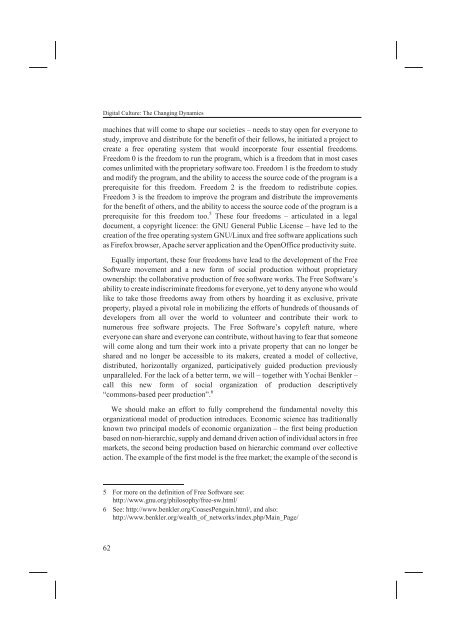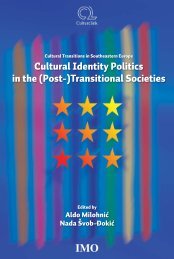D:\Documents and Settings\Ana\My Documents\Biserka-knjiga ...
D:\Documents and Settings\Ana\My Documents\Biserka-knjiga ...
D:\Documents and Settings\Ana\My Documents\Biserka-knjiga ...
You also want an ePaper? Increase the reach of your titles
YUMPU automatically turns print PDFs into web optimized ePapers that Google loves.
Digital Culture: The Changing Dynamics<br />
machines that will come to shape our societies – needs to stay open for everyone to<br />
study, improve <strong>and</strong> distribute for the benefit of their fellows, he initiated a project to<br />
create a free operating system that would incorporate four essential freedoms.<br />
Freedom 0 is the freedom to run the program, which is a freedom that in most cases<br />
comes unlimited with the proprietary software too. Freedom 1 is the freedom to study<br />
<strong>and</strong> modify the program, <strong>and</strong> the ability to access the source code of the program is a<br />
prerequisite for this freedom. Freedom 2 is the freedom to redistribute copies.<br />
Freedom 3 is the freedom to improve the program <strong>and</strong> distribute the improvements<br />
for the benefit of others, <strong>and</strong> the ability to access the source code of the program is a<br />
prerequisite for this freedom too. 5 These four freedoms – articulated in a legal<br />
document, a copyright licence: the GNU General Public License – have led to the<br />
creation of the free operating system GNU/Linux <strong>and</strong> free software applications such<br />
as Firefox browser, Apache server application <strong>and</strong> the OpenOffice productivity suite.<br />
Equally important, these four freedoms have lead to the development of the Free<br />
Software movement <strong>and</strong> a new form of social production without proprietary<br />
ownership: the collaborative production of free software works. The Free Software’s<br />
ability to create indiscriminate freedoms for everyone, yet to deny anyone who would<br />
like to take those freedoms away from others by hoarding it as exclusive, private<br />
property, played a pivotal role in mobilizing the efforts of hundreds of thous<strong>and</strong>s of<br />
developers from all over the world to volunteer <strong>and</strong> contribute their work to<br />
numerous free software projects. The Free Software’s copyleft nature, where<br />
everyone can share <strong>and</strong> everyone can contribute, without having to fear that someone<br />
will come along <strong>and</strong> turn their work into a private property that can no longer be<br />
shared <strong>and</strong> no longer be accessible to its makers, created a model of collective,<br />
distributed, horizontally organized, participatively guided production previously<br />
unparalleled. For the lack of a better term, we will – together with Yochai Benkler –<br />
call this new form of social organization of production descriptively<br />
“commons-based peer production”. 6<br />
We should make an effort to fully comprehend the fundamental novelty this<br />
organizational model of production introduces. Economic science has traditionally<br />
known two principal models of economic organization – the first being production<br />
based on non-hierarchic, supply <strong>and</strong> dem<strong>and</strong> driven action of individual actors in free<br />
markets, the second being production based on hierarchic comm<strong>and</strong> over collective<br />
action. The example of the first model is the free market; the example of the second is<br />
5 For more on the definition of Free Software see:<br />
http://www.gnu.org/philosophy/free-sw.html/<br />
6 See: http://www.benkler.org/CoasesPenguin.html/, <strong>and</strong> also:<br />
http://www.benkler.org/wealth_of_networks/index.php/Main_Page/<br />
62



